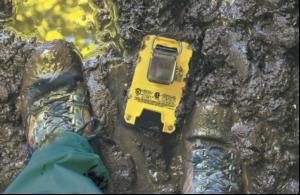Agas monitor is a complex system
that includes a sensor
surrounded by sensitive
electronics, alarms, a battery and a
display. When you turn the instrument
on, you can easily see that the battery
and display are working
Agas monitor is a complex system
that includes a sensor
surrounded by sensitive
electronics, alarms, a battery and a
display. When you turn the instrument
on, you can easily see that the battery
and display are working properly. But
what about the rest of the instrument?
Do the sensors and alarms work at all?
What if the instrument was dropped
causing the sensor to break internally?
Did the sensor and alarm openings
become obstructed when it fell in the
mud? How do you know?
In order to verify the functionality of
sensor(s) and alarms, a "bump" test of a
portable gas detector should be
performed before use each and every
time. A brief exposure to a gas
concentration greater than the instrument
alarm set points applied during a bump
test confirms that the sensors and alarms
function properly.
In a previous white paper, "Why
Bump Testing Saves Lives: New data
reveals the correlation between bump
test frequency and gas detector failures,"
Dave Wagner, Director of Product
Knowledge at Industrial Scientific,
discussed how data collected from more
than 27,000 gas detectors shows that
three in every 1,000 instruments used on
a daily basis are likely to fail a bump test
and subsequently fail to respond
properly to gas if it is encountered
during use. This study was originally
conducted in 2009 by Dr. Raghu
Arunachalam, Ph.D., who is the Director
of Emerging Technologies at Industrial
Scientific Corporation. Since then, this
likelihood has been confirmed in data
collected over a period of eight years
from nearly 47,000 gas detectors. As
clear as this evidence is, workers still
continue to use instruments without
bump testing them first. Why?
Many organizations find it difficult to
bump test detectors as frequently as is
needed. Calibration stations and
docking systems have made these
challenges easy to overcome. They
also save the time that it would take
for an operator to perform the same
function manually.
Another option that has gained
momentum in recent years is
subscribing to Gas Detection
as a Service, in which case
bump testing is automated
and automatic equipment
replacements are provided when
necessary. Plus, subscribers have full
visibility into their gas detection
program.
In any case, portable gas detectors are
precise electronic devices that play a
critical role in protecting workers. Their
ability to do their job properly is not
always visually apparent. The only way to
be certain that a portable gas detector will
respond properly when it encounters a
life threatening gas condition is to test it
with a known concentration of the target
gas before you use it.


